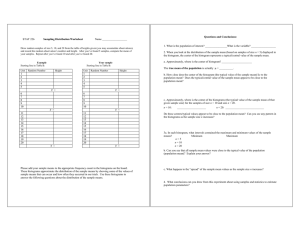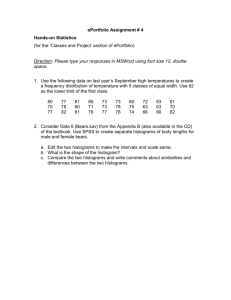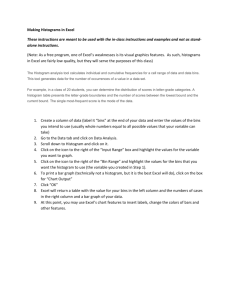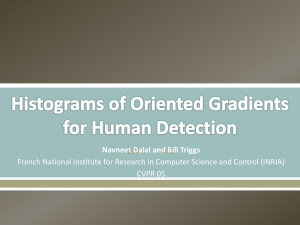Unsupervised Learning and Interactive Jazz/Blues Improvisation Belinda Thom
advertisement
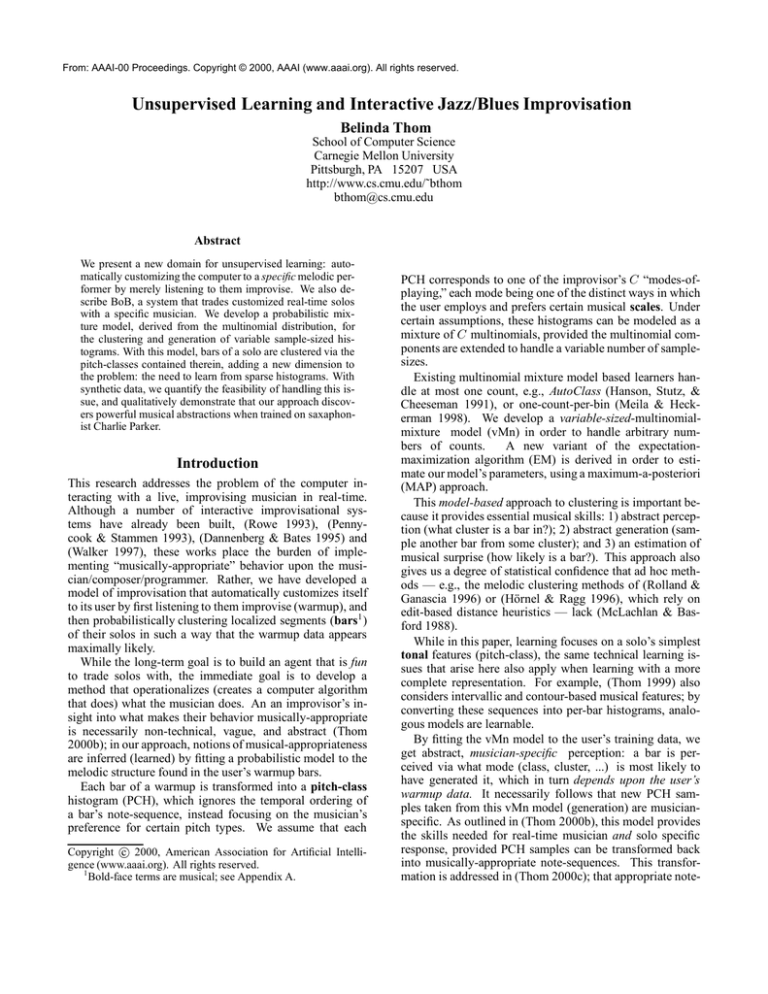
From: AAAI-00 Proceedings. Copyright © 2000, AAAI (www.aaai.org). All rights reserved.
Unsupervised Learning and Interactive Jazz/Blues Improvisation
Belinda Thom
School of Computer Science
Carnegie Mellon University
Pittsburgh, PA 15207 USA
http://www.cs.cmu.edu/˜bthom
bthom@cs.cmu.edu
Abstract
We present a new domain for unsupervised learning: automatically customizing the computer to a specific melodic performer by merely listening to them improvise. We also describe BoB, a system that trades customized real-time solos
with a specific musician. We develop a probabilistic mixture model, derived from the multinomial distribution, for
the clustering and generation of variable sample-sized histograms. With this model, bars of a solo are clustered via the
pitch-classes contained therein, adding a new dimension to
the problem: the need to learn from sparse histograms. With
synthetic data, we quantify the feasibility of handling this issue, and qualitatively demonstrate that our approach discovers powerful musical abstractions when trained on saxaphonist Charlie Parker.
Introduction
This research addresses the problem of the computer interacting with a live, improvising musician in real-time.
Although a number of interactive improvisational systems have already been built, (Rowe 1993), (Pennycook & Stammen 1993), (Dannenberg & Bates 1995) and
(Walker 1997), these works place the burden of implementing “musically-appropriate” behavior upon the musician/composer/programmer. Rather, we have developed a
model of improvisation that automatically customizes itself
to its user by first listening to them improvise (warmup), and
then probabilistically clustering localized segments (bars1 )
of their solos in such a way that the warmup data appears
maximally likely.
While the long-term goal is to build an agent that is fun
to trade solos with, the immediate goal is to develop a
method that operationalizes (creates a computer algorithm
that does) what the musician does. An an improvisor’s insight into what makes their behavior musically-appropriate
is necessarily non-technical, vague, and abstract (Thom
2000b); in our approach, notions of musical-appropriateness
are inferred (learned) by fitting a probabilistic model to the
melodic structure found in the user’s warmup bars.
Each bar of a warmup is transformed into a pitch-class
histogram (PCH), which ignores the temporal ordering of
a bar’s note-sequence, instead focusing on the musician’s
preference for certain pitch types. We assume that each
c 2000, American Association for Artificial IntelliCopyright gence (www.aaai.org). All rights reserved.
1
Bold-face terms are musical; see Appendix A.
PCH corresponds to one of the improvisor’s C “modes-ofplaying,” each mode being one of the distinct ways in which
the user employs and prefers certain musical scales. Under
certain assumptions, these histograms can be modeled as a
mixture of C multinomials, provided the multinomial components are extended to handle a variable number of samplesizes.
Existing multinomial mixture model based learners handle at most one count, e.g., AutoClass (Hanson, Stutz, &
Cheeseman 1991), or one-count-per-bin (Meila & Heckerman 1998). We develop a variable-sized-multinomialmixture model (vMn) in order to handle arbitrary numbers of counts.
A new variant of the expectationmaximization algorithm (EM) is derived in order to estimate our model’s parameters, using a maximum-a-posteriori
(MAP) approach.
This model-based approach to clustering is important because it provides essential musical skills: 1) abstract perception (what cluster is a bar in?); 2) abstract generation (sample another bar from some cluster); and 3) an estimation of
musical surprise (how likely is a bar?). This approach also
gives us a degree of statistical confidence that ad hoc methods — e.g., the melodic clustering methods of (Rolland &
Ganascia 1996) or (Hörnel & Ragg 1996), which rely on
edit-based distance heuristics — lack (McLachlan & Basford 1988).
While in this paper, learning focuses on a solo’s simplest
tonal features (pitch-class), the same technical learning issues that arise here also apply when learning with a more
complete representation. For example, (Thom 1999) also
considers intervallic and contour-based musical features; by
converting these sequences into per-bar histograms, analogous models are learnable.
By fitting the vMn model to the user’s training data, we
get abstract, musician-specific perception: a bar is perceived via what mode (class, cluster, ...) is most likely to
have generated it, which in turn depends upon the user’s
warmup data. It necessarily follows that new PCH samples taken from this vMn model (generation) are musicianspecific. As outlined in (Thom 2000b), this model provides
the skills needed for real-time musician and solo specific
response, provided PCH samples can be transformed back
into musically-appropriate note-sequences. This transformation is addressed in (Thom 2000c); that appropriate note-
sequences can be derived from order-ignorant histograms is
due to the fact that in the complete representation scheme,
histograms embed more temporal knowledge (intervals depend on successive note pairs; contours upon note strings).
In this paper, we describe our solo trading system and its
learning scenario. We introduce the vMn model and an EMbased method for fitting its parameters to the training data.
We discuss the unique challenge that arises in this domain.
Specifically, training sets are small (≈ 120 histograms), and
each histogram is relatively sparse (while there are 12 discrete and nominal pitch-class values, the expected number
of counts per histogram is ≈ 12.2). This research addresses
not only how to learn a vMn model, but what we can learn
from challengingly sparse datasets. The “what” question
is investigated by: 1) quantitatively evaluating the performance of synthetic datasets; and 2) qualitatively evaluating
the musical-appropriateness of the pitch-class modes that are
learned for Bebop saxaphonist Charlie Parker.
In addition to presenting a novel domain and demonstrating that powerful musical abstractions emerge with this
vMn approach, our work is significant because it empirically
demonstrates that probabilistic clustering of sparse, unlabelled histograms is useful. This success is in part due to
the fact that we take advantage of the knowledge that per
histogram, all counts are generated by the same component,
whereas “one count” style approaches treat each as independent of the others. Histograms with larger sample-sizes have
more information with which to distinguish themselves — it
makes sense to directly incorporate this knowledge into the
learning process.
Band-out-of-a-Box (BoB)
We are building Band-OUT-of-a-Box (BoB), an interactive
soloist that trades bars of a customized solo with a single musician (Thom 2000b). We now describe how BoB’s
melodic representation is used to configure itself to the user.
generate new PCHs with: 1) situation and musician based
specificity; and 2) per-bar real-time response.
Representational Issues
Solo segmentation is per bar. While this small, fixed time
window (≈ 2 [sec]) affords fine-grained responsiveness, it
means that PCHs are sparse; it is also the reason that samplesize varies.
Offline learning must occur quickly; small training sets
are desirable. Also, musically, local context is crucial (Thom
2000a); one cannot assume that combining multiple warmup
sessions necessarily yields better customization.
Unsupervised Learning
We now introduce our probabilistic model, vM n(Ω), a mixture of C variable-sized multinomials. Parametric inference is non-trivial when training data is both observable
(histogram bin counts) and unobservable (which component
generated what histograms). Learning amounts to segregating the histograms according to those bins that are most
heavily used (or vacant).
Example
A subset (21 histograms) of sparse, simulated dataset II (described later) is shown in Figure 1. Each subplot is a different histogram. Bin counts are stacked wire boxes. The
gray columns reflect the shape of a histogram’s generative
probabilities, indicating which bins are highly probable, or
important.
This dataset, generated by seven components, is displayed
so that each column of subplots has the same generator.
Thus, x1 is generated by the same component as x8 and x15 .
As x1 ’s first bin has three counts, and this bin is gray, we
know these counts make x1 more likely. “×” marked subplots are less likely, so much so that even when the generative model’s parameters are known, if we have to guess these
histogram generators, we would guess incorrectly.
The Domain
BoB is specifically designed for the following scenario.
Each time the musician wants to trade solos, they first
warmup (for ≈ 10 minutes), improvising freely over a desired song at a fixed tempo. During this time, BoB collects training data by recording their note-stream in realtime. Next, BoB goes offline, creating training set X =<
x1 , . . . , xi, . . . , xn > by: 1) segmenting the note-stream
into bars; 2) building one PCH per bar. (Note our use of upper and lower-case letters to distinguish between data points
and sets). For PCH xi, an m = 12 dimensional histogram,
xij is P
the number of times that pitch-class j occurs in bar i.
m
szi = j=1 xij is the total sample-size.
BoB uses a stability/usefulness heuristic to estimate how
many playing modes, Ĉ , are present in the training data,
which in turn, allows a Ĉ -component vMM parameterization, Ω̂, to be estimated so that X appears maximally likely.2
When BoB goes back online, trading bars of solo with the
musician in real-time, Ω̂ is used to abstractly perceive and
2
The hat superscript denotes an estimate.
x1
x2
x3
x4
x5
x6
x7
x8
x9
x10
x11
x12
x13
x14
x15
x16
x17
x18
x19
x20
x21
Figure 1: A subset of dataset II
The purpose of this example is to illustrate that learning is
not trivial. Even knowing the column-arrangement, (which
is equivalent to having labels), when the gray columns are
hidden, it is not obvious which bins of each component are
most important. This figure also illustrates some subtle issues related to sparsity. For example, while smaller than
average sample-sizes (szi ≤ 8) coincide with 45 of the ×’s
(x2 , x3 , x5 , x9 ), the smallest sample-size (x18 ) is not only
correctly classified but also has its counts placed on important bins. On the other hand, while x10 has the largest sz, 13
of its counts are misleading (reside on non-important bins).
Also, in many cases, counts without gray backgrounds do
not hurt classification, although they may hurt learning. On
example of this is x8 , where non-important counts happen to
reside on bins that do not cause other components to appear
more likely.
Larger histogram dimensions mean that more bins could
be important when estimating generators, which means that
sample-size may be distributed amongst more bins, less information regarding a particular bin may be available. On
the flip side, more dimensions means less chance for competing components to interfere with one another. Regardless, with sparsity, specific examples are not likely to contain enough information by themselves, which also affords
more powerful generalization! A rigorous probabilistic procedure, one that weighs larger sample-sizes more heavily,
especially when they boost other data, is needed.
Music Issues
Modelling PCHs with vMn introduces strong assumptions:
1. For each bar, the musician chooses at random from a fixed
set of probabilities in order to determine what mode (component) to use. Thus, the musician does not switch modes
mid-bar, each bar’s mode has nothing to do with its neighboring bar’s mode, etc.
2. Per bar, mode and the number of notes played are independent. The number of notes in different bars are also
independent.
3. For a given a mode, one pitch-class does not depend upon
another (feature independence). Melodically, this means
that previously improvised notes do not affect future notes
(and vice-versa).
4. Pitch-class bins are nominal/discrete. We do not impose
any similarity metric upon pitch-class values.
5. Bars that contain more notes contain more information
about what mode the musician is realizing (PCHs are not
normalized).
The first three items deal with independence, reducing the
model’s complexity, making it less susceptible to overfitting. As (Nigam et al. 1998) notes, the focus on decision
boundaries often makes a classifier robust to independence
violations. Most serious is Item 1; musical bars certainly affect one another — our datasets are not independently sampled. Fortunately, the quality of our music results empirically validates our approach’s usefulness.
Item 4 is crucial. While simpler pitch-class similarity
schemes have been used to provide learning feedback —
e.g., Euclidean, or the δ−based distance metric used to
train melody generation in (Feulner & Hörnel 1994) —
other context-dependent aspects (for example, scales) are
more perceptible musically (Bartlett 1993). Our nominal
viewpoint allows another mechanism, and, importantly, a
customizable one, to determine pitch-class similarity: how
likely is it that certain values are preferred in a given mode?
The Multinomial Distribution
The multinomial family, M nom(sz, θ), extends the binomial so as to handle more than two discrete, nominal outcomes. Sample-size sz is constant; θ is the
r−dimensional probability vector used to weight outcomes
< 1, . . . , 2, . . . , r >. When sampling from this distribution,
v ∼ M nom(sz, θ), v is an r-dimensional histogram with sz
trials distributed amongst r bins. Histogram likelihood is:
m
Y
vj !
v
Pr(v|sz, θ) =
j=1
sz!
(θj ) j .
The vMn Distribution
We now define the variable-sized multinomial mixture
model, vM n(Ω), where ind(·) maps a single-count histogram (vector) into the index of the bin that contains the
count (scalar):
sz ∼ ind(Mnom(1, η))
y = ind(z), where z ∼ Mnom(1, π)
x|y ∼ Mnom(sz, θy ).
The multinomial components of this model,
Θ =< θ1 , . . . , θc , . . . , θC >, control the distribution of
counts among bins. Variable sample-size is handled by
assuming that a histogram’s generator, y, and its samplesize, sz, are independent. Ω refers to parameters Θ, π,
and η. π =< π1 , . . . , πc, . . . , πC > controls how often a
component is chosen; η =< ηmin(sz), . . . , ηmax(sz) > how
often particular sample-sizes occur. The joint likelihood,
< x, y >, or equivalently < x, z >, is:
Pr(x, y|Ω) = Pr(sz|η)Pr(y|π)Pr(x|sz, θy ).
Naive Bayes Classification and vMn
With estimate Ω̂ a Naive-Bayes-Classifier can be built,
which maps histograms into one of Ĉ classes. Bayes-Rule
is used to turn the generative model around, so that the component posteriors, ẑ =< z1 , . . . , zc, . . . , zĈ >, can be estimated:
zy = Pr(y|x, Ω̂) =
π̂y Pr(x|sz, θˆy )
Pr(y|Ω̂)Pr(x|y, Ω̂)
= PC
.
Pr(x|Ω̂)
πˆ Pr(x|sz, θˆc )
c=1 c
Component estimation (abstract perception) is then:
ŷ = argmaxc Pr(c|x, Ω̂) .
Ŷ and Ẑ are the dataset’s estimated generators and posteriors respectively. With synthetic data, we also know Y , the
true generative components.
With synthetic data, Ω is known, so we can build an
Optimal-Bayes-Classifier, whose component estimation (denoted by superscript “∗”), is guaranteed to have a minimal
expected error rate:
err∗ = E [y 6= y∗ ] ≈
|Y 6= Y ∗ |
= e∗ .
n
The “≈” here indicates our estimation of this expectation.
err∗ quantifies the hardness of parameterization Ω, which
depends upon the overlap between component distributions,
and is a function of the entire input space. Our approximation, e∗ , is based on finite dataset X. When the learning algorithm knows C, hardness can also provide a lower bound
with which to compute the additional loss of having to infer
Ω:3
∆err
|Y 6= Ŷ |
= E [y =
6 ŷ] − E [y 6= y∗ ] ≈
− e∗ = ∆e .
n
The values of e∗ and ∆e that we report are based on an
independent test set.
LU (X|Ω̂t) = LU (X|Ω̂t+1 ). In practice, a computer’s preci-
sion requires another form of termination (we stop after 8
digits of improvement and/or 1500 iterations).
EM involves two steps per iteration. The E-step calculates E[LL (X, Z|Ω̂t)]. Indicator vector Z is the only
random variable, so this expectation amounts to solving Ẑ t = E[Z|X, Ω̂t ], whose solution is the posteriors,
ẑit = Pr(y|xi , Ω̂t ).
In the M-step, Ẑ t is used in place of Z. Ω is re-estimated
according to Ω̂t+1 = argmaxv (LL (X, Ẑ t |v)). The solution to
this equation is
Unsupervised Learning and vMn
For independent and identically sampled histograms, average log-likelihood of labelled dataset < X, Y > is:
log(Pr(X, Y |Ω̂))
=
n
Pn
log(Pr(szi |η̂)) + log(π̂yi ) + log(Pr(xi|szi , θ̂yi ))
i=1
.
n
LL (X, Y |Ω̂) =
(1)
For an unlabelled dataset, Y and C are hidden. Average
log-likelihood is now the joint marginalized with respect to
the posterior:
log(Pr(X|Ω̂))
=
n
Pn
PC
log(Pr(szi |η̂)) + log
z π̂ Pr(xi |szi , θ̂c )
i=1
c=1 ic c
.
n
LU (X|Ω̂) =
(2)
Warmup PCHs are unlabelled; BoB seeks to estimate Ω̂ so
that LU is maximized. However, Ĉ must be estimated elsewhere, for to optimize it here is under-constrained.
In vMn, sample-size does not affect classification, which
is not to say that as sz increases, classification does not become easier. In fact, sz and err∗ are inversely related. However, in and of itself, sz provides no information about which
component generated a histogram.
With synthetic data, the loss in likelihood associated with
having to infer Ω can also be estimated:
∆l = l∗ − LU (X|Ω̂), where l∗ = LU (X|Ω)
These values are also based on an independent test set.
EM and vMn
Supervised and unsupervised learning both amount to finding an Ω̂ for which their appropriate L is maximal. It is
the log of sums in LU that makes its optimization difficult
(whereas a closed-form optimum for LL exists). LU ’s optimization is non-linear and has multiple roots. We use the
EM-algorithm to control the search for local optima (Dempster, Laird, & Rubin 1987). This search is repeated multiple
(25) times from different random starting points; the best
(most likely) solution is reported.
With each subsequent iteration at time t, EM guarantees that LU (X|Ω̂t) ≤ LU (X|Ω̂t+1). In theory, finding
a local maximum is equivalent to finding a fixed-point,
3
Ŷ must first be permuted to approximate Ω’s ordering.
t+1
θcj
Pn
Pr(zic |xi , Ω̂t )
1+n
Pn
t
1
+
Pr(z
ic |xi , Ω̂ )xij
m
i=1
=
,
Pn P
m
1 + i=1 j=1 Pr(zic|xi , Ω̂t )xij
πct+1
=
1
C
+
i=1
Both of these estimates are MAP-based: optimal Bayesian
parameter estimation, augmented by Laplacean priors on π
and θ (Vapnick 1982).
From an improvisational standpoint, the θ priors encode
the reasonable musical assumption that no pitch-class is
never played. The appropriateness of π’s priors depends
upon the appropriateness of Ĉ ; they encode the belief that
the musician is never not going to use one of their “Ĉ ” playing modes.
Estimating C
Estimating C by optimizing LU is under-constrained.
Rather than adding more constraints, we pick Ĉ to be the
largest value that produces a stable and useful clustering of
the training set.
A stable C is defined as one that, when five identical
learning experiments are run, produces no disagreements on
pair-wise comparisons of solutions. A useful C is defined
as one that, on average, is well separated (whose estimated
error is below 0.20). Stability quantifies the discrepancies
between pairs of solutions’ partitioning of the training set,
shedding light upon how repeatable a learning solution is
— how real it is. In BoB, usefulness makes sense: we are
most interested in adapting to those playing modes that are
markedly different.
Related Work
We know of no other work that empirically validates the
feasibility of fully unsupervised vMn learning, or presents
learning details for for the fully unsupervised case. While a
full-blown vMn style model was used in text-classification
(Nigam et al. 1998), the focus was on combining labelled and unlabelled data, and sample-size was ignored
(histograms were normalized). Fully unsupervised multinomial mixture models usually impose serious restrictions
upon the number of samples allowed; in (Hanson, Stutz, &
Cheeseman 1991) sz = 1. Another common approach, discussed in (Meila & Heckerman 1998), (Hanson, Stutz, &
Cheeseman 1991) and (McLachlan & Basford 1988), is to
demand that each bin has at most one count. We have developed a new model for this domain because it is important
Results: Synthetic Data
This domain introduces unique challenges — variable
sample-size and sparsity. We now quantify the degree to
which learning in such conditions is possible.
In particular, we generate training and test sets with:
C = 7, πc = C1 , n = 175 (≈ 25 histograms per cluster),
m = 12, and sz ∼ U niform(3, 15). On the one hand,
we report optimistic results because our learning algorithm
knows C. On the other hand, our parameterizations of Ω
make learning more difficult than it is likely to be for PCH
data. For example, our uniform sz has a larger variance and
a smaller mean than Parker’s bell-shaped distribution. Also,
our components are as “entropic” as possible. Specifically,
for each component, four bins are equally important (have
high probability α of occurring). The other eight bins are
equally non-important (have low probability β). Each component’s important bins are arranged so as to provide maximal interference with the other component’s important bins.
Thus, discriminating these histograms requires sets of features; single features are never sufficient.
We quantified learning performance for three datasets,
each harder (having larger e∗ ) than its predecessors. The
values in the right five columns are averaged over 25 experiments. ∆× is the number of misses directly caused by
having to learn (compare this to n = 175 total guesses).
dataset
I
II
III
α
.248
.21
.188
β
.001
0.02
.031
l∗
-9.2
-12
-13
∆l
0.18
0.38
0.40
e∗
0.11
0.22
0.31
∆e
0.00
0.07
0.16
∆×
0
12
28
While having to learn degrades a classifier’s accuracy, and
the harder the problem, the worse the degradation, the average cost of having to learn (∆e) ranges from negligible to 12
of the optimal (e∗ ). To add some perspective, consider the
worst case, III. We expect to miss 0.47 guesses; an optimal
classifier would miss 0.31; a random classifier would miss
0.85. Even with this sparse data (some is shown in Figure 1),
learning produces useful results.
Results: Music Data
We now qualitatively argue that our approach produces powerful, customized abstraction when applied to Parker’s PCH
data. This argument is all the more crucial given that, during solo improvisation, vMn assumptions are likely to be
violated.
Our training set was Parker’s Mohawk improvisations
(Goldsen 1978). Figure 2 (left) displays how BoB perceived
these solos. Each subsequent row is Parker’s next Mohawk
solo (chorus). The columns are each choruses’ bars. The
symbol shown in each < bar, chorus > indicates what
mode BoB assigned it to. The corresponding mode generator estimates are shown in Figure 2 (right). While Ĉ = 4 and
5 were both stable/useful, solution Ĉ = 4 is presented due
to space limitations. Details concerning the chords, scales,
and melodic styles of the Bebop genre are beyond this paper’s scope. The goal here is to merely provide a flavor of the
powerful types of musical abstractions that were discussed
in (Thom 1999).
1
2
3
4
chorus
to consider the additional information that larger histograms
provide.
5
6
7
8
9
10
1
2
3
4
5
6
7
8
9
10 11 12
bar
Figure 2: Mohawk: Clustering Ŷ (left); Parameters θ̂c (right)
Several musically appropriate correlations emerge when
and were
80
most common, accounting for 119
of the bars.4 The gray
backgrounds of these components (right, Figure 2) identify those pitch-classes in the b[ -Bebop-Major and e[ -BebopDominant scales respectively. Given the key of this song (a
12-bar blues in b[ ), it is appropriate that Parker used these
scales, especially since they were invented in part to explain
his playing style (Baker 1983).
To cite another example, notice the segregation of modes
as a function of column (bar), which makes sense given that
the chords change (and hence the underlying tonal function
changes) on bars 1, 5, 7, 9 and 11. A particularly important
change occurs in bars 5-6, the only columns in which Parker
exclusively uses the Bop-modes. Another case is bars 9-10,
the only place were is used more than 50% of the time.
Also, bar 12 ends the blues progression. At this point if another chorus is played, it has the musical distinction of being called a “turn-around,” whereas if the tune ends, (which
is the case in choruses 5 and 10), then a resolution to the
tonic (b[ ) is expected. BoB captured Parker’s accommodation of these distinctions, using
(the e[ -Major scale) in
turn-arounds and restating the tonic via the b[ -Bop mode.
The component we have not yet discussed, , exemplifies another powerful aspect of our approach. Notice how
all pitch-classes but e[ (the bin between d and e) are reasonably probable. While it is musically reasonable to view
this component as the b[ -Major scale (shown in gray), by
itself, this viewpoint is limited. For example, with respect
to we know: 1) how often on average Parker chooses to
include non-scalar pitch-classes; 2) that scale-tone e[ , rather
than the non-scalar and musically special “tritone” e, is more
surprising; 3) how Parker employs modes in particular contexts (e.g., a choruses’ mode-sequence).
In short, a musician’s specific improvisational style is embedded, or distributed within the learned representation at
multiple different and important levels, giving BoB knowledge about what contexts a mode can be used in, what contexts the musician is in, and how to realize a particular mode
(i.e., which pitches are most important).
Ω̂ and Ŷ are analyzed. For example, modes
4
No notes were played in < 5, 8 >; this bar was omitted.
Conclusion
We have presented a novel domain for unsupervised learning: automatically customizing the computer to its specific
melodic performer by listening to them improvise. We also
described our system BoB, which performs this task in the
context of real-time four bar solo trading. We developed
a probabilistic mixture model of variable-sized multinomials and a procedure that uses this model to learn how to
perceive/generate variable-sized histograms. Because this
model was used to cluster per-bar pitch-class histograms,
we added a new dimension to the problem: the need to
learn from sparse data, and use synthetic data to show that
useful results can be learned in this case. We have also
shown that when trained on saxophonist Charlie Parker,
powerful musical abstractions emerge on many levels. For
example, Parker’s playing-modes (scales, or sub/supersets
of scales) are distributed among a component parameters,
which in turn quantifies the relative importance of various
pitch-classes, giving us an idea of how to realize a particular
mode (something rule/scale-based systems must be told how
to do). Parker’s contextual employment of mode, which allows one to consider generating new like-minded contexts,
is also embedded within this learned representation, opening
up a whole new range of creative possibilities.
Appendix A: Musical Terms
Term
bar
pitchclass
(PC)
octave
scale
tonal
chord
Definition
the grouping caused by the regular recurrence of accented beats, typically 4 taps of a listener’s foot (e.g.,
≈ 2.5 seconds)
a pitch’s tone, that piano key on the single octave piano
that would be played if octave was ignored: P C ∈
{c, d[ , d, ..., b[ , b}
two pitches with the same PC and 1:2 frequency ratio
a subset of PC’s differing in pitch according to a specific scheme
the principle of key in music conveyed through the
family relationship of all its tones and chords, (one affect of this is your being able to sing doh-re-mi-fa-...
on top of a given harmony/melody)
combination of pitches simultaneously performed,
producing more or less perfect harmony
References
Baker, D. 1983. Jazz improvisation : A Comprehensive Method
of Study For All Players. Frangipani Press.
Bartlett, J. C. 1993. Tonal structure of melodies. In Tighe, T. J.,
and Dowling, W. J., eds., Psychology & Music: the Understanding of Melody & Rhythm. Lawrence Erlbaum Associates, Inc.
Dannenberg, R. B., and Bates, J. 1995. A model for interactive
art. In Proceedings of the Fifth Biennial Symposium for Arts &
Technology, 103–111.
Dempster, A. P.; Laird, N. M.; and Rubin, D. B. 1987. Maximum
likelihood from incomplete data via the em algorithm. Journal of
the Royal Statistical Society.
Feulner, J., and Hörnel, D. 1994. Melonet: Neural networks that
learn harmony-based melodic variations. In Proceedings of the
1994 ICMC. International Computer Music Association.
Goldsen, M. H., ed. 1978. Charlie Parker Omnibook: For C
Instruments. Atlantic Music Corp.
Hanson, R.; Stutz, J.; and Cheeseman, P. 1991. Bayesian classification theory. Technical Report FIA-90-12-7-01, NASA Ames
Research Center.
Hörnel, D., and Ragg, T. 1996. Learning musical structure and
style by recognition, prediction and evoloution. In Proceedings
of the 1996 ICMC. International Computer Music Association.
McLachlan, G. J., and Basford, K. E. 1988. Mixture Models:
Inference & Applications to Clustering. Marcel Dekker.
Meila, M., and Heckerman, D. 1998. An experimental comparison of several clustering and initialization methods. Technical
Report MSR-TR-98-06, Microsoft Research Center.
Nigam, K.; McCallum, A.; Thrun, S.; and Mitchell, T. 1998.
Learning to classify text from labeled & unlabeled documents. In
Proceedings of the 1998 AAAI. AAAI Press.
Pennycook, B., and Stammen, D. 1993. Real-time recognition
of melodic fragments using the dynamic timewarp algorithm. In
Proceedings of the 1993 ICMC. International Computer Music
Association.
Rolland, P., and Ganascia, J. 1996. Automated motive-oriented
analysis of musical corpuses: a jazz case study. In Proceedings of
the 1996 ICMC. International Computer Music Association.
Rowe, R. 1993. Interactive Music Systems : Machine Listening
& Composing. MIT Press.
Thom, B. 1999. Learning melodic models for interactive melodic
improvisation. In Proceedings of the 1999 ICMC. International
Computer Music Association.
Thom, B. 2000a. Artificial intelligence and real-time interactive
improvisation. In Proceedings from the AAAI-2000 Music and AI
Workshop. AAAI Press.
Thom, B. 2000b. Bob: an interactive improvisational music companion. In Proceedings of the Fourth International Conference on
Autonomous Agents.
Thom, B. 2000c. Generating musician-specific melodic improvisational response in real-time. Submitted to the International
Computer Music Conference.
Titterington, D. M.; Smith, A. F. M.; and Makov, U. E. 1981. Statistical Analysis of Finite Mixture Distributions. Wiley & Sons.
Vapnick, V. 1982. Estimation of Dependences Based on Emperical Data. Springer-Verlag.
Walker, W. 1997. A computer participant in musical improvisation. In CHI 97 Electronic Publications.

